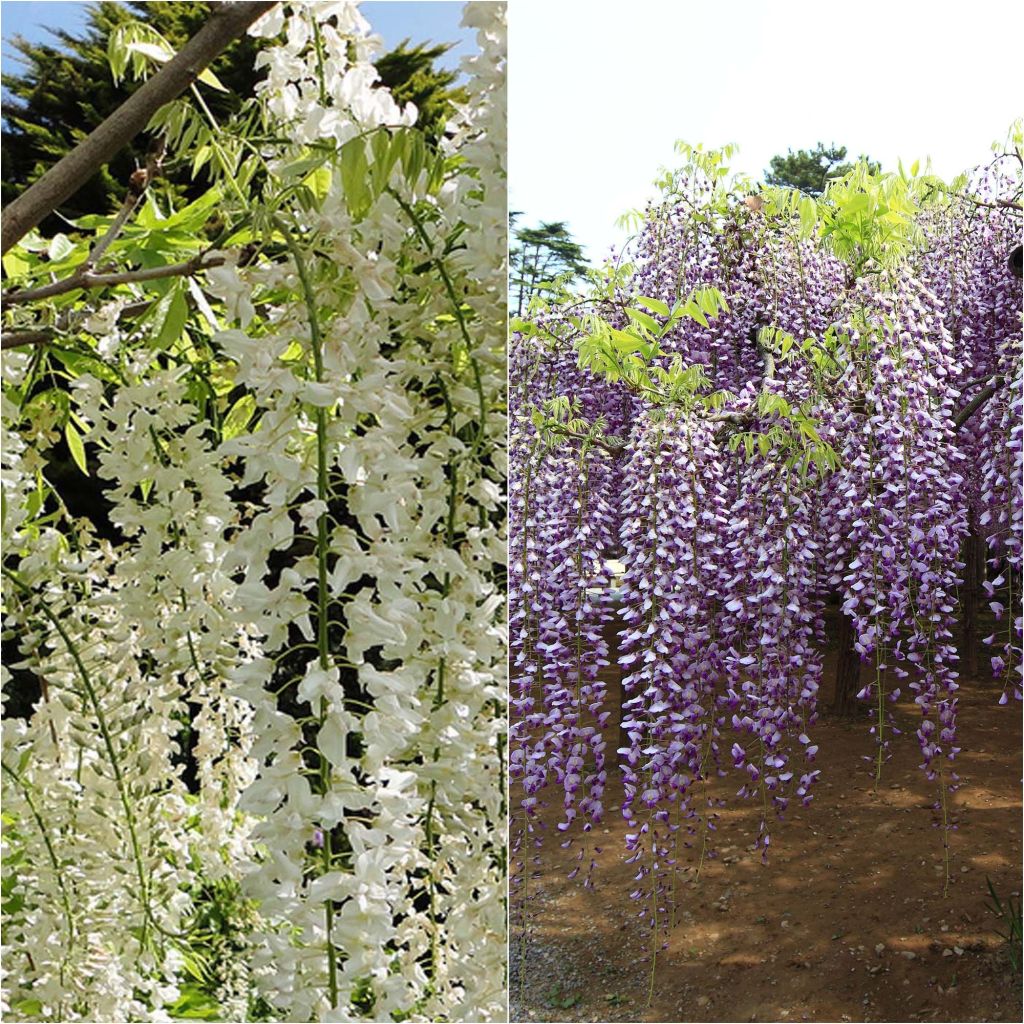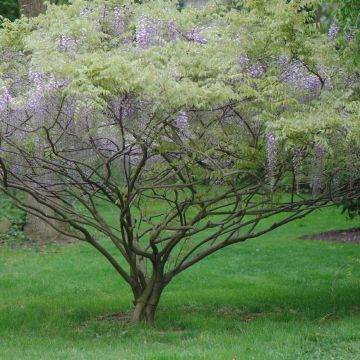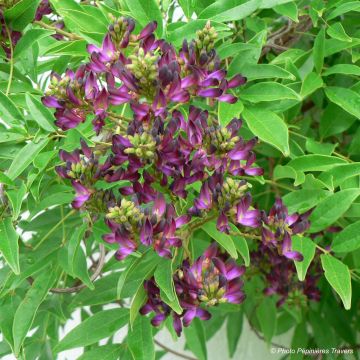Shipping country and language
Your country of residence may be:
Your country of residence is:
For a better user experience on our website, you can select:
Your shipping country:
-
Andorra
-
Austria
-
Belgium
-
Bulgaria
-
Canada
-
Chile
-
Croatia
-
Cyprus
-
Czechia
-
Denmark
-
Estonia
-
Finland
-
France
-
Germany
-
Greece
-
Hungary
-
Iceland
-
Ireland
-
Italy
-
Latvia
-
Lithuania
-
Luxembourg
-
Malta
-
Monaco
-
Netherlands
-
Poland
-
Portugal
-
Romania
-
Slovakia
-
Slovenia
-
Spain
-
Sweden
-
Switzerland
-
United Kingdom
We only deliver seed and bulb products to your country. If you add other products to your basket, they cannot be shipped.
Language:
-
French
-
German
-
Spanish
-
English
-
Italian
My Account
Hello
My wish lists
Log in / Register
Existing customer?
New customer?
Create an account to track your orders, access our customer service and, if you wish, make the most of our upcoming offers.


Collection of 2 Wisterias with very long clusters
Collection of 2 Wisterias with very long clusters
Wisteria floribunda Alba, Macrobotrys
Fast delivery, impeccable packaging, but one of the Floribunda Alba duo is weak and broken. Honestly, I do not recommend this purchase.
Nicole, 12/04/2020
Order in the next for dispatch today!
Dispatch by letter from 3,90 €.
Delivery charge from 5,90 € Oversize package delivery charge from 6,90 €.
More information
This item is not available in your country.
Shipping country:
-
Andorra
-
Austria
-
Belgium
-
Bulgaria
-
Canada
-
Chile
-
Croatia
-
Cyprus
-
Czechia
-
Denmark
-
Estonia
-
Finland
-
France
-
Germany
-
Greece
-
Hungary
-
Iceland
-
Ireland
-
Italy
-
Latvia
-
Lithuania
-
Luxembourg
-
Malta
-
Monaco
-
Netherlands
-
Poland
-
Portugal
-
Romania
-
Slovakia
-
Slovenia
-
Spain
-
Sweden
-
Switzerland
-
United Kingdom
Schedule delivery date,
and select date in basket
This plant carries a 6 months recovery warranty
More information
We guarantee the quality of our plants for a full growing cycle, and will replace at our expense any plant that fails to recover under normal climatic and planting conditions.
From 5,90 € for pickup delivery and 6,90 € for home delivery
Express home delivery from 8,90 €.
Would this plant suit my garden?
Set up your Plantfit profile →
Collection items (2 plants)
Description
A pair of exceptional Japanese Wisterias with their inflorescences, which can reach or exceed 1m in length. It brings together two spectacular forms of Wisteria floribunda: the first with white flowers, and the other with mauve-violet flowers, both blooming together in May, while the young leaves unfold. Due to their size, as well as their layered arrangement on the vegetation, hanging in large, slightly fragrant curtains, the flower clusters give these two vines an unparalleled elegance. They spontaneously and voluptuously wrap their long voluble stems around trellises, fences, pergolas, and arbors. Given their growth, these two giants are best suited for large gardens.
This pair consists of a Japanese Wisteria Alba plant (Wisteria floribunda Alba) and a Macrobotrys Wisteria plant (Wisteria floribunda Macrobotrys).
The floribunda wisteria, Wisteria floribunda (or multijuga) in Latin, is a climbing plant with large growth and rapid growth belonging to the large family of legumes, just like clover, alfalfa, and lupins. It is native to the forests of Japan. Its long voluble stems, which can reach 8 to 10m in length, lignify with age. Sometimes a bit slow to establish, it is a robust plant, perfectly resistant to cold (-20°C), not very demanding in terms of soil (although it fears active limestone), capable of growing in poor and dry soils in summer if they are sufficiently deep.
The long stems of the Japanese wisteria turn spontaneously clockwise around supports. The growth of new shoots is very rapid, several meters in a season in cool soil. Flowering takes place in May, more or less early depending on the climate, on fairly young grafted plants. It develops on newly foliated branches located near the main lignified stems. Clusters of loose, papilionaceous flowers, at least 1m long, spread a light floral fragrance in calm weather. White in the Longissima Alba variety, they are mauve-lilac in 'Macrobotrys'. They open successively along the cluster, from the base to the top. After the flowers, pendant, flat, green pods appear, turning brown when ripe. Bronze young leaves appear at the end of flowering and then turn a light green color. They are divided into 13 to 19 ovate and tapered leaflets, giving the foliage a light appearance. Very long-lasting, Wisteria can live well over 50 years. Its flowering is nectar-rich and honey-producing. The deciduous foliage turns a beautiful yellow color in autumn, before falling.
Wisteria is the ultimate romantic plant. A queen in the realm of climbing plants, capable of enhancing a facade or structure, no matter how modest. When two varieties of wisteria with very long clusters intertwine, the spectacle becomes simply grandiose. Particularly useful for dressing up a large, somewhat dull wall or covering an unsightly fence, this pair wraps around a trellis or large fence without restraint if allowed. And these two wisterias tend to smother surrounding plants. Preferably, choose a solitary location for them, in full sun or partial shade in a hot climate. Or, if you have enough space, associate them with plants as powerful as they are: the Paul's Himalayan Musk rose, the Tetrarose montana clematis, the Fallopia aubertii...
However, be patient: the first flowering of Wisteria may not appear until 2 to 3 years, depending on the growing conditions.
Report an error about the product description
Plant habit
Flowering
Foliage
Botanical data
Wisteria
floribunda
Alba, Macrobotrys
Fabaceae
Cultivar or hybrid
Other Wisterias
Planting and care
Glycine floribunda is a vine-plant that is easy to grow in all our regions, as long as the soil it is planted in is sufficiently deep and loose. It can grow in any garden soil, with a preference for poor soils. However, it prefers an acidic to neutral soil and may wither in a limestone soil. Once established, it can withstand summer drought and requires no watering. Plant it along a wall or train it on a pergola. Pruning is recommended to promote better flowering. Glycines can be trained as a tree by elevating them on a "parasol" stake of 1.5 to 2 m, or as a ground cover.
Planting period
Intended location
Care
-
, onOrder confirmed
Reply from on Promesse de fleurs
Haven't found what you were looking for?
Hardiness is the lowest winter temperature a plant can endure without suffering serious damage or even dying. However, hardiness is affected by location (a sheltered area, such as a patio), protection (winter cover) and soil type (hardiness is improved by well-drained soil).

Photo Sharing Terms & Conditions
In order to encourage gardeners to interact and share their experiences, Promesse de fleurs offers various media enabling content to be uploaded onto its Site - in particular via the ‘Photo sharing’ module.
The User agrees to refrain from:
- Posting any content that is illegal, prejudicial, insulting, racist, inciteful to hatred, revisionist, contrary to public decency, that infringes on privacy or on the privacy rights of third parties, in particular the publicity rights of persons and goods, intellectual property rights, or the right to privacy.
- Submitting content on behalf of a third party;
- Impersonate the identity of a third party and/or publish any personal information about a third party;
In general, the User undertakes to refrain from any unethical behaviour.
All Content (in particular text, comments, files, images, photos, videos, creative works, etc.), which may be subject to property or intellectual property rights, image or other private rights, shall remain the property of the User, subject to the limited rights granted by the terms of the licence granted by Promesse de fleurs as stated below. Users are at liberty to publish or not to publish such Content on the Site, notably via the ‘Photo Sharing’ facility, and accept that this Content shall be made public and freely accessible, notably on the Internet.
Users further acknowledge, undertake to have ,and guarantee that they hold all necessary rights and permissions to publish such material on the Site, in particular with regard to the legislation in force pertaining to any privacy, property, intellectual property, image, or contractual rights, or rights of any other nature. By publishing such Content on the Site, Users acknowledge accepting full liability as publishers of the Content within the meaning of the law, and grant Promesse de fleurs, free of charge, an inclusive, worldwide licence for the said Content for the entire duration of its publication, including all reproduction, representation, up/downloading, displaying, performing, transmission, and storage rights.
Users also grant permission for their name to be linked to the Content and accept that this link may not always be made available.
By engaging in posting material, Users consent to their Content becoming automatically accessible on the Internet, in particular on other sites and/or blogs and/or web pages of the Promesse de fleurs site, including in particular social pages and the Promesse de fleurs catalogue.
Users may secure the removal of entrusted content free of charge by issuing a simple request via our contact form.
The flowering period indicated on our website applies to countries and regions located in USDA zone 8 (France, the United Kingdom, Ireland, the Netherlands, etc.)
It will vary according to where you live:
- In zones 9 to 10 (Italy, Spain, Greece, etc.), flowering will occur about 2 to 4 weeks earlier.
- In zones 6 to 7 (Germany, Poland, Slovenia, and lower mountainous regions), flowering will be delayed by 2 to 3 weeks.
- In zone 5 (Central Europe, Scandinavia), blooming will be delayed by 3 to 5 weeks.
In temperate climates, pruning of spring-flowering shrubs (forsythia, spireas, etc.) should be done just after flowering.
Pruning of summer-flowering shrubs (Indian Lilac, Perovskia, etc.) can be done in winter or spring.
In cold regions as well as with frost-sensitive plants, avoid pruning too early when severe frosts may still occur.
The planting period indicated on our website applies to countries and regions located in USDA zone 8 (France, United Kingdom, Ireland, Netherlands).
It will vary according to where you live:
- In Mediterranean zones (Marseille, Madrid, Milan, etc.), autumn and winter are the best planting periods.
- In continental zones (Strasbourg, Munich, Vienna, etc.), delay planting by 2 to 3 weeks in spring and bring it forward by 2 to 4 weeks in autumn.
- In mountainous regions (the Alps, Pyrenees, Carpathians, etc.), it is best to plant in late spring (May-June) or late summer (August-September).
The harvesting period indicated on our website applies to countries and regions in USDA zone 8 (France, England, Ireland, the Netherlands).
In colder areas (Scandinavia, Poland, Austria...) fruit and vegetable harvests are likely to be delayed by 3-4 weeks.
In warmer areas (Italy, Spain, Greece, etc.), harvesting will probably take place earlier, depending on weather conditions.
The sowing periods indicated on our website apply to countries and regions within USDA Zone 8 (France, UK, Ireland, Netherlands).
In colder areas (Scandinavia, Poland, Austria...), delay any outdoor sowing by 3-4 weeks, or sow under glass.
In warmer climes (Italy, Spain, Greece, etc.), bring outdoor sowing forward by a few weeks.











